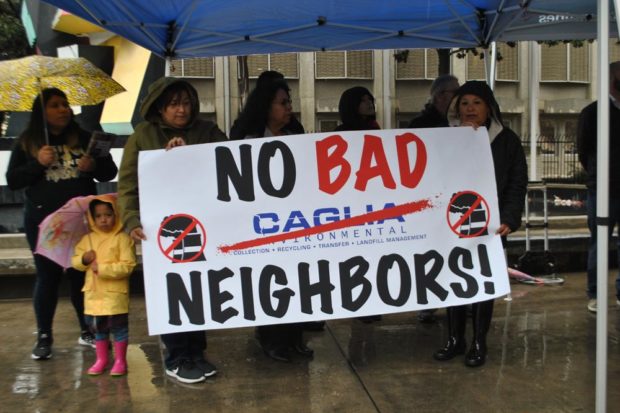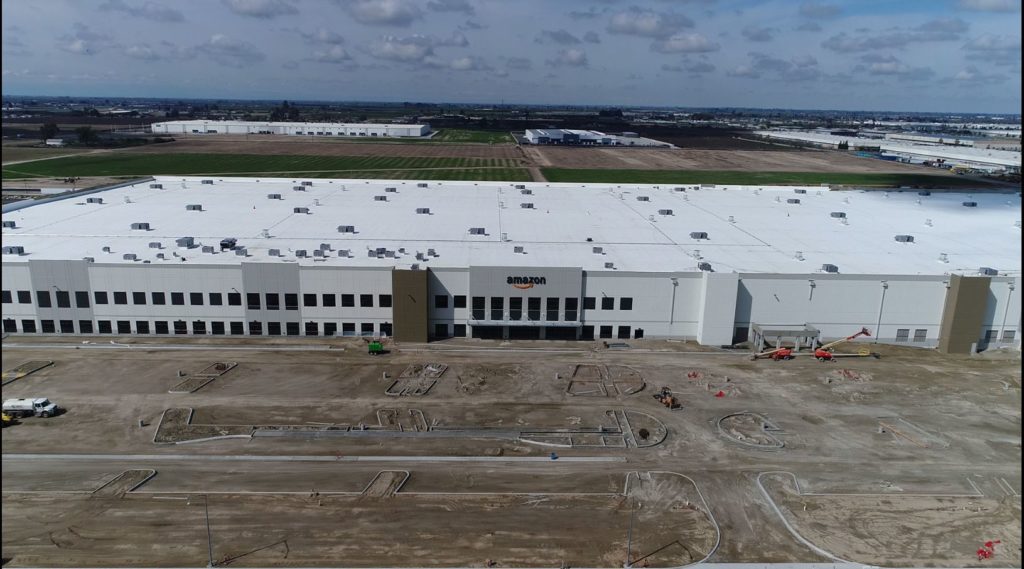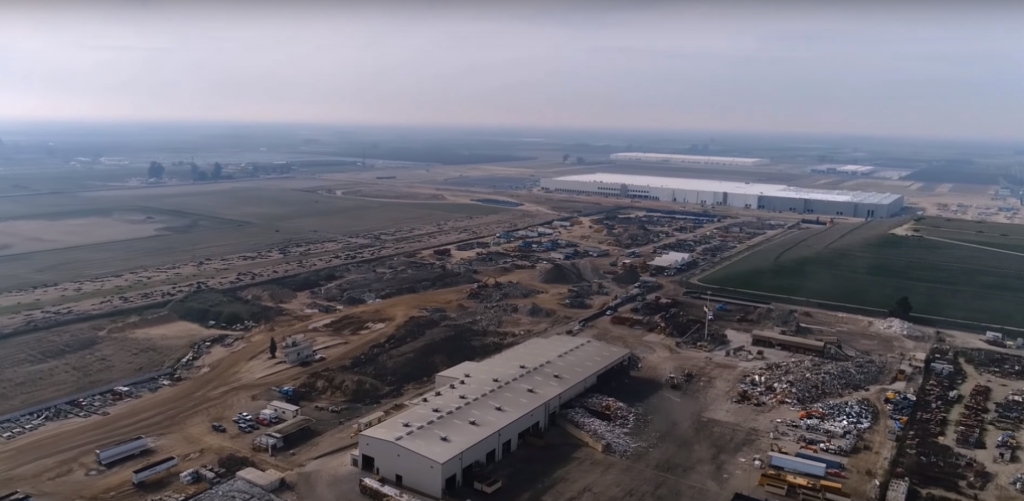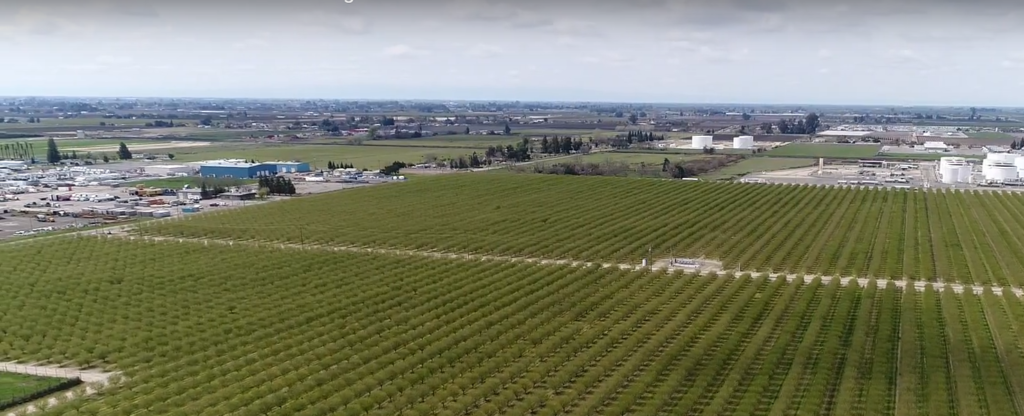
By Kevin Hall
A recent unanimous vote by the Fresno City Council threatens to knock the city’s developer-controlled politics right off its old foundations. The legislative temblor struck in late January when the opposing plates of profit and public health converged, cracking open a deep fissure in the city’s current land-use decision-making practices. At its core are environmentally racist practices at odds with state law and the city’s own policies.
At stake are millions of dollars in investment, thousands of new jobs and the health of everyone in the city⎯particularly the very lives of south-central Fresno residents, including students at Orange Center Elementary School in Daleville. At issue are unevaluated health and environmental impacts from rapid industrial development occurring in the “Reverse Triangle,” an ever-widening slice of rural land located between Highways 41 and 99 and from Jensen Avenue to as far south as the city limit at Malaga Avenue and the city sphere at American Avenue three miles distant.
Like layers in a collapsing building, the cumulative pollution burden placed on residents in the area, according to CalEnviroScreen, is at the worst level in California, with a ranking in the 100th percentile for negative impacts. Population characteristics are those of a Valley farmworker community: two-thirds of families live in poverty; three-fourths of households have no adults fluent in English, and virtually all the school’s students are on the free and reduced lunch program.
But under the rallying cry of “Jobs! Jobs! Jobs!” it appears Jennifer Clark, Fresno’s director of development and resource management, has been advised by the mayor, the City Council and the city attorney to approve large-scale industrial projects without requiring site-specific environmental impact reports (EIRs); instead, the city maintains that its 2014 General Plan Update’s city-wide EIR suffices.
Clearly unlawful, the extent of the practice is not known. It could be happening throughout all the city’s industrial zones, perhaps residential and commercial properties, too.
What is known is that within the Reverse Triangle developers of the recent major warehouse distribution centers built for Amazon and Ulta Beauty Products were not required by the city to comply with the California Environmental Quality Act (CEQA). And on Jan. 25, the Council voted 7-0 to allow a third major complex to ignore the law, too.
Institutional racism is the only name for such actions, and a demand for environmental justice is the moral response.
Neg-Dec
The specific agenda item on Jan. 25 was a mitigated negative declaration of environmental impacts (“Neg-Dec”) submitted for Richard Caglia and Caglia Environmental’s proposed 110-acre industrial development along a half mile of Central Avenue between Orange and Cedar avenues. The loosely defined proposal would allow up to seven buildings totaling more than 2 million square feet in size, triple the CEQA review threshold of 650,000 square feet.
According to an independent analysis by Tamura Environmental of Petaluma, submitted to the city on behalf of South-Central Neighbors United in mid-January, the exhaust from the estimated 6,260 additional truck and commuter trips daily would top 50 tons of oxides of nitrogen (NOx) annually. A key component of ozone and fine particulate pollution, 50 tons of NOx is five times the legal threshold of 10 tons annually, the level at which polluters are required to comply with air district regulations.
Caglia, who is usually angling for garbage collection and recycling contracts or privatization of public waste divisions, has officially joined the ranks of developers. He and his extended family’s business interests regularly make $1,000–$2,500 contributions to local politicians, but in 2016 they really stepped it up to become Mayor Lee Brand’s biggest supporter. A collection of a half-dozen Caglia family interests contributed more than $40,000 to the mayoral campaign, more than double the amount Caglia interests donated to all Fresno City Council races in 2014 and 2016 combined.
In City Hall on Jan. 25, dozens of residents and supporters asked the Council to reject the Neg-Dec. The term spat like an epithet by environmental health advocates is shorthand for the city’s favorite cutting tool when slashing red tape for developers. When used correctly, it presents an accurate, preliminary review of impacts to determine if a full EIR is warranted. When used badly, people pay with their lives.
A lawsuit currently underway points out that the city failed to “analyze or mitigate the Project’s foreseeable air quality impacts even though the community surrounding the Project site already experiences one of the heaviest pollution burdens in the State; adequately analyze or mitigate the Project’s groundwater impacts even though the King Sub-basin is in critical overdraft; include any analysis or appropriate mitigation relating to the disturbance of soils on a site adjacent to and with no physical separation from a landfill and another hazardous waste site.” The Neg-Dec also fails to address greenhouse gas emissions.
South-central residents made impassioned pleas for further environmental studies. They described the suffering that comes from living in an area at the bottom of the barrel statewide when it comes to the specific chemical exposures in their soil, air and water. It’s a frightening list of toxics. It comes as no small irony that the Caglia-operated Cedar Avenue Recycling Center and its companion, the Caglia-owned but closed landfill, the Orange Avenue Landfill, already has a state-mandated groundwater remediation program in place.
“We’re humans. We’re being neglected. We breathe the air,” said 50-year resident Leo Macias. Macias is a cancer survivor, as is his adult son, Daniel, who added, “Please think about this very carefully before you approve it.” The Maciases attributed the health crises of several families living there to the chronic toxic exposures in the groundwater, soil and air.
In a letter to the City Council, Macias’s longtime neighbor of 40-plus years, Katie Taylor, wrote that all concerned are “forsaking the advocacy and cries of our people to seek research and answers to our community’s health concerns.” Taylor has lost three family members to cancer.
Laura Jacinto, who also lives on Central Avenue, said, “My worst fear is that my children and I contract something like Valley Fever when the dirt stars getting moved around” and cited her concerns about neighbors’ cancer and other illnesses. “Tell me what’s going on with our community.”
Their demands for further study, communication and mitigation were bolstered by the support of local nonprofits Legal Leadership Counsel for Justice and Accountability (LCJA), Faith in Fresno and Fresno Building Healthy Communities. The LCJA submitted in-depth comments on the project’s inconsistencies with the city’s own General Plan and Development Code requirements to protect homes from industrial facilities located next nearby and the Neg-Dec’s inadequacies and secured an 11th-hour submission from Shute, Mihaly & Weinberger LLP, a major legal firm based in San Francisco with a depth of experience in CEQA. They, in turn, secured the independent, preliminary analysis from Tamura.
All are working together in coalition with South-Central Neighborhoods United. On Feb. 22, they filed their court case to challenge the decision in Fresno Superior Court. They merely seek a legally compliant environmental review and mitigation process, and adherence to existing standards in the general plan, development code, and community plan.
The group also enjoys support from Friends of Calwa, Central Valley Air Quality Coalition, Central Valley Asthma Collaborative, Building Youth Tomorrow Today, Fr. Art Gramaje of Saint Anthony Claret Church and Cristo Rey Mission in Malaga; Fr. Joaquin Arriaga of Our Lady of Mount Carmel Catholic Church and parishioners, and Rev. B.T. Lewis from Rising Star Missionary Baptist Church.
Leadership Counsel’s Ashley Werner has been at the forefront of the policy debate with the city, having triggered the planning commission and City Council votes with an appeal of the development director’s approval of the Neg-Dec in November. Werner, like nearly every other person who spoke in December and again in January, asked the Council to conduct a full environmental review.
A Boston College Law School graduate with six years in Fresno, Werner wrote in a March 8 Fresno Bee column, “The behavior of the city of Fresno’s representative council reflects a harrowing disregard for residents’ concerns about the impacts of the city’s land use decisions will have on their health, safety and welfare.” She also described in her remarks before the city council on Jan. 25 how Amazon and Ulta are now legally beyond any requirements to measure and offset their profound impacts.
Not Another West Fresno
However, despite clear requests for further study, Fresno City Council Member Oliver Baines led the response and spoke only as if residents wanted the land rezoned and all industrial development halted. More than 10 people asked for further study while just one resident asked for no further development, but Baines seized on the word “rezone” and in an off-topic, 18-minute-long haranguing of his constituents, he repeated more than two dozen times that the land has been zoned industrial since the 1984 General Plan; it will be always be zoned industrial, and it won’t be rezoned. He ignored the fact that the overwhelming number of comments in opposition were to the Neg-Dec, not the existing zoning.
Although Baines is correct when he points out this isn’t like West Fresno with industry next to “intense residential” neighborhoods, it could be the next West Fresno or Calwa⎯for all of us. CEQA-free industrial developments across south-central will feed huge new volumes of air pollution directly into the Fresno Eddy, the slow-moving, nighttime air current circling anticlockwise over the entire Fresno-Clovis metropolitan region of more than a half million people.
Yet those potential impacts pale next to the health and environmental impacts being endured directly by south-central residents and in adjacent Calwa and West Fresno, with more pollution yet to come. Fortunately, the law is written to protect everyone, even those living in rural communities of 50–80 homes or in unfinished city neighborhoods. Council President Esmeralda Soria would do well to explain to Baines, who was raised in southern California, how such disadvantaged unincorporated communities came to exist.
As a former staffer at California Rural Legal Assistance Foundation with experience in rural communities, Soria might then want to consider more carefully the area’s abundant need for protection and project-level EIRs. No groundwater, soil, traffic or air pollution studies for the adjacent farmworker communities of Daleville and Britten? Those families’ children are now walking to school along Cherry and Central avenues in the county with no sidewalks but scores of daily truck and construction equipment trips to the city’s industrial sites.
The votes by the city’s four White council members came as little surprise, but the words of Baines and Soria and the complete silence of District 5 representative Luis Chavez were a great disappointment to many. Mayor Lee Brand has been calling for a business-friendly, red-tape-cutting approach to development for years now, and apparently, this is what he had in mind. Then, of course, there’s the business sector and its long list of campaign contributors: landowners, developers, builders, contractors, chambers of commerce, economic development departments and the list goes on.
To hear them describe it, Fresno has the slowest, least responsive development department in the state and is responsible for the city’s endemic high unemployment rate. Brand’s red-tapeless calculation is thus to attract warehouse distribution centers with tax breaks and no environmental review; unemployment will drop by half to match statewide levels, eliminating air pollution and poverty. Done!
Lee Ann Eager, CEO of Fresno County Economic Development Corporation, explained it this way: “I was born and raised here, and I certainly understand the issues that we have with air quality, with high unemployment, with high poverty. The only way for us to get out of all of those things is to put people to work.”
That’s the voice of White privilege, of course, which almost always adopts such a paternalistic tone and simplistic arguments when telling people of color to be quiet because progress is coming through. Joining Eager was former City Council member and current city staffer Larry Westerlund, who is Fresno’s director of economic development.
Ironically, it was Baines, who is Black and represents the area, who most embraced those same attitudes. In a huffy lecture from the dais, he scolded residents and activists, criticizing them for their ignorance and condescendingly offered to “walk them through the General Plan.”
Baines’ air of patriarchy extended so far as to include West Fresno residents present, such as the iconic Mary Curry of Concerned Citizens of West Fresno. He intoned, “There are people in here that…know exactly what we’re doing,” seeming to imply that somehow the Southwest Specific Plan that he “put residents through” included a negotiation to allow heavy industrial in south-central.
It was a bewildering monologue. There is the sense about Baines of a City Council member in the final year of his political career now with one eye on his future employment prospects.
During public comments, Curry had earlier reminded the Council, “We said we wanted things clean in our neighborhood, but we didn’t want people to dump in other neighborhoods. When any part of the city suffers, we all pay a price one way or the other, and I’m concerned about the price that the neighborhoods in that area will pay.”
Soria joined Baines by thanking him for his “clarifications,” leaving observers mystified. Council Member Luis Chavez, whose district abuts the area and whose downwind constituents will share the brunt of this pollution with south-central residents, stayed silent; he never asked a question, never made a comment.
By contrast, Chavez exhibits great energy for soft topics such as tax incentives for businesses. Given that area of interest, he might choose to lead the Council into a careful reexamination of the city’s $30 million in tax incentives to Amazon for a facility that was going to locate here regardless, as reported by the Fresno Bee’s Tim Sheehan. In 2016, Sheehan also reported on an additional $12 million–$15 million in infrastructure spending.
But first, the entire City Council, the mayor and the city attorney must enjoy a court-ordered walkthrough of the California Environmental Quality Act and the city’s own General Plan, Development Code and Roosevelt Community Plan, all of which they’re blatantly violating. In the process, taxpayers will fund the bill for the City Council’s ineptness and its subpar legal counsel; in turn, this serves as a subsidy to Caglia and company, who will not bear any of the court costs as it appears the confident city did not require Caglia to indemnify it from litigation.
The city’s defense, and the basis for the Council’s misinformed argument is that when it approved an updated General Plan and Master EIR in 2014, the citywide mitigation measures described there were sufficient for industrial development in the Reverse Triangle. It’s an improbable argument⎯and a proven failure legally⎯but as long as no one was objecting, major pollution-producing projects were sailing through the approval process down at City Hall.
The city’s environmentally racist position is that air pollution levels and impacts on nearby residents from the Caglia project’s estimated 6,200 daily truck and car trips need not be evaluated and mitigated. Instead, the impacts of diesel exhaust from thousands of daily truck trips on south-central residents are offset by lumping them with the drastically lower air pollution levels of, say, Mayor Brand’s north-end neighborhood or Caglia’s in Old Fig Garden, both filled with low-polluting passenger vehicles and no industry, hazardous waste emitters, landfills, chrome-plating plants, wholesale oil distributors and more.
Layers of Institutional Racism
South-central residents and allies are dealing directly with the City of Fresno’s baked-in barriers to equity, but beneath them at the countywide and regional level are deeper layers of bedrock support for the city’s institutionalized racist policies.
On the transportation planning side of things, the Council of Fresno County Governments appears similarly disinterested in the concerns of residents. The 143rd and final item on its draft work plan for 2018–2019 is an evaluation of the impending “serious challenges” from trucks and commuters in the Reverse Triangle, including American Avenue. Unfortunately, in its work plan spreadsheet, the row for “Public Engagement” has been left blank. Mayor Brand represents the city on the COG Policy Board.
An even deeper layer is the valley-wide, eight-county problem known as the San Joaquin Valley Air Pollution Control District. One clue to the genesis of Brand’s red-tape-letting came in the Brenntag Pacific hearing in 2014 when the city approved the chemical plant’s move from Calwa to West Fresno, a move that also received a Neg-Dec. In this instance, Brand sang the praises of the impartiality and accuracy of the air pollution district and its determination of “less than significant” impacts, but he also briefly mentioned that he and fellow north-end White Council Member Steve Brandau had met a few months prior with the air district head. Why?
Presumably, Brand in his quixotic quest to cut CEQA, found a kindred in spirit in the head of the district, Sayed Sedredin, who has traveled repeatedly to Washington, D.C., to lobby for elimination of deadlines and fines in the federal Clean Air Act. Baines, who served on the air board for seven years, supports that position and has joined such lobbying trips.
The district, a polluter-controlled agency, has crafted a loophole in its trucking warehouse rule large enough to, well, drive a million-square-foot, diesel-choked warehouse distribution center through. True to its pollution-friendly ways, the air district is foot-dragging its way through a rule update necessitated by a successful lawsuit against the City of Visalia in 2013⎯five years ago⎯for a mere 500,000-square-foot warehouse also seeking to skirt CEQA by relying on a General Plan’s EIR. The Ulta Beauty Products built in 2017 and the nearly finished Amazon fulfillment center are a combined 1.5 million square feet alone.
Caglia seeks to add another 2 million. And there’s plenty of bare ground remaining. On the south side of Central Avenue, between it and American, from Cedar Avenue to Highway 99, another square mile of mostly prime farmland lies waiting, a fourth of which is already within city limits and zoned heavy industrial. The remaining 500 acres are within the city’s sphere of influence.
It presumably didn’t soothe Baines’ amygdala any when LCJA Policy Advocate Erica Fernandez reminded the Council that it has yet to begin on the Industrial Compatibility Assessment (ICA) committed to in the same 2014 General Plan so heavily relied on by the city to justify its dangerous actions. “Leadership Counsel offered to help the city seek enough funds to do it, but the city has not responded,” she said. An ICA would identify problems just like this one in advance and assist in good land-use planning.
But Baines’ mood already had been hijacked. South-Central Neighborhoods United had earlier pointed out in writing to the city that even the air district’s staff had called for a full EIR and application of its Indirect Source Rule. That rule would assess impact fees from trucking facilities and use them to mitigate their impacts on surrounding schools and residences. Air filtration is an important step when facing such toxic exposures from diesel, particularly in classrooms. The mayor and the City Council are all aware that Fresno is the focus of a long-term study demonstrating diesel exhaust’s damage to local children’s DNA.
But the City Council and counsel all stayed mute. They came into the meeting prepared to endure a ritual of public comment and move on.
Baines, the seven-year Valley Air Board veteran, had told Channel 30 reporter Cory James the night before the Caglia Neg-Dec vote, “We’ve done everything we can as a city to mitigate whatever health impacts are going to be out there.” He made that statement without benefit of any health impact analyses, which is what mere adherence to CEQA would generate.
But, the air district warehouse rule comes without enforcement. Unless residents find a nonprofit environmental justice organization such as Leadership Counsel to represent them legally, they will find themselves systematically excluded from the system through steep litigation costs, disinterested elected officials and a lack of transparency at City Hall. For example, residents should have access on the city Web site to all Development Department director–approved projects because they will not receive a public notice in such cases.
Their City Council member might sit on the air board and their mayor on the COG, but there they serve as guards protecting a framework of injustice, unwittingly perhaps, but there all the same.
The EDC’s Eager made the best observation of the night: “We are the fifth largest city in the sixth largest economy in the world, and we have to act like it.”
The Environmental Justice Framework: “The EJ framework is our preferred alternative to the dominant environmental protection paradigm which for decades institutionalized unequal enforcement; traded human health for profit; placed the burden of proof on the victims and not the polluting industry; legitimized human exposure to harmful chemicals, pesticides and hazardous substances; promoted “risky” technologies; exploited the vulnerability of economically and politically disenfranchised communities; subsidized ecological destruction; created an industry around risk assessment; and failed to develop pollution prevention as the overarching and preferred strategy. Yet today, a quarter-century after the environmental justice framework was adopted, all communities are still not created equal.”⎯Dr. Robert Bullard https://ensia.com/voices/environmental-justice/
*****
Kevin Hall is a former Fresno County Planning Commissioner and a long-time air quality advocate.




[…] record on transportation and public health, Community Alliance readers might recall Eager from an article published in the April 2018 issue, “Tectonic Forces Converge: Walls of Institutional Racism Sway […]
[…] in a lawsuit first reported in the April 2018 Community Alliance, South Central Neighbors United then sued the city for failing to protect public […]
[…] Counsel for Justice and Accountability, which represents South-Central Fresno Neighbors United and succeeded in forcing an environmental review of the neighboring 2-million-square-foot Caglia project in 2018, […]